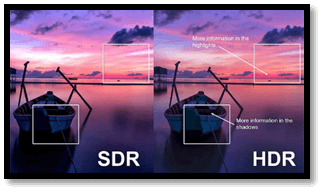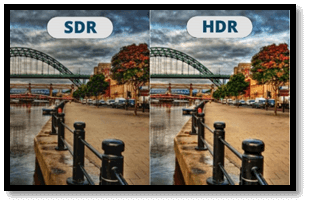What is the full form of HDRHDR: High Dynamic RangeHigh Dynamic Range (HDR) is a term that refers to a dynamic range that is greater than average; other common terms are wide dynamic range (WDR), extended dynamic range, and expanded dynamic range. It is a set of procedures that combine various exposure into a single image that includes the whole range of brightness. In general, it is mixing two or more final photographs made from separate images of the same scene shot at various exposure settings. In contrast to a second, lighter exposure, which can capture features in the scene's mid-tones and shadows, one darker exposure can capture information in the scene's bright parts. When used together, the two can produce an image with significantly more optimum tonal detail. 
The terminology is frequently used while making a reference to the dynamic range of diverse signals, including audio, video, radio, and image signals. It may be applicable to analog and digital signals as well as the tools used for recording, processing, and recreating these signals. The term is also used to refer to a few technologies or methods that enable the creation of media with a high dynamic range, such as photos, movies, and audio. ApplicationsThe terminology "high dynamic range" in this context refers to a scene or image with a wide range of lighting conditions. The dynamic range of a picture or image is the range of brightness between the brightest and darkest areas. The term "high dynamic range imaging" (HDRI) refers to a group of image processing technologies and methods that enable the expansion of an image's or a video's dynamic range. It involves the collection, production, storage, transmission, and presentation of pictures and films. Historical movies can be transformed even though manual intervention would've been required for some frames (like when black-and-white pictures are changed to colour). Modern movies are frequently shot with cameras that have a higher dynamic range. Additionally, both HDR photography and rendering are necessary for special effects, particularly those that combine real and synthetic video. HDR imagery is also required for an application that requires high accuracy in order to capture temporal features of scene changes. This is crucial for applications such as surveillance video systems, the car industry's predictive driver assistance systems, and the surveillance of some industrial processes like welding. 1. DisplayA display's dynamic range is the range of luminosity it is capable of reproducing, from its darkest level to its brightest point. The brightness of the whitest, brightest, and darkest blacks that a monitor is capable of producing are measured as the contrasts of a display. The overall dynamic range of screens could be increased due to several advancements in technology. BrightSide Technologies presented the very first HDR display at the Society for Info Display's Display Week Symposium in May 2003. The display utilized a set of individually controlled LEDs arranged underneath a traditional LCD panel, a technique now referred to as "local dimming." Later, BrightSide released a number of associated display & video technologies that made it possible to view HDR material. Dolby Laboratories bought BrightSide Technologies in April 2007. OLED screens feature excellent contrast. MiniLED enhances context. 2. CaptureMulti-exposure HDR capture is the main idea. A method in videography and photography known as High Dynamic Range (HDR) enables an increase in the dynamic range of acquired images and films beyond the camera's natural capability. It entails taking several frames of the exact same picture at various exposures, merging them into one, and producing an image with a wider dynamic range than the individual acquired frames. Modern smartphones and cams may even include sensors that merge the two images simultaneously on-chip. Additionally, without in-pixel compression, a broader dynamic range is immediately exposed to the operator for display or processing. Some security camera systems can automatically provide two or more images with varying exposures for each frame in order to capture HDR footage. For instance, a sensor designed for 30 frames per second will output 60, with the odd frames exposed for a shorter period of time and even frames for a longer amount of time. High dynamic range photos can frequently be captured by contemporary CMOS image sensors with a single exposure. The necessity for the multiple exposures HDR capturing method decreases as a result. Images with a high dynamic range are employed in high dynamic range applications, such as welding and automotive operations. Wide dynamic range is the term used in place of HDR in security cameras. Image artifacts may frequently occur due to the nonlinearity of various sensors. 
3. RenderingRendering with a high dynamic range. Real-time rendering & display of virtual environments with a dynamic range of at least 65,535:1 is known as high-dynamic-range rendering (HDRR) (used in computer, gaming, & entertainment technology). 4. Compression or expansion of the dynamic rangeThe dynamic range of the picture storage, transmission, display, and printing technologies is constrained. Tone mapping is required to lower the dynamic range of photos that were made or taken while it is higher. 5. StorageMore dynamic range can be stored in image/video files with high dynamic range formats than with conventional 8-bit gamma standards. These formats consist of the following:
Industrial Light & Magic Co. (ILM) developed OpenEXR in 1999, and it was made available as an open-source software library in 2003. Production of movies and television shows uses OpenEXR. In December 2014, the Academy of Motion Picture Arts and Sciences (AMPAS) introduced the Academy Colour Encoding System (ACES). ACES is a full-featured colour & file management system that can handle a wide colour gamut and HDR and integrates with practically any professional workflow. 6. Transmission to displaysThe term "high dynamic range" (HDR) refers to a technique that enables the transmission of high dynamic range films and visuals to compatible screens. Additionally, other features of the transmission of images, such as colour gamut, are enhanced by this technique. Displays that are able to use that technology are referred to as HDR displays in this context. Formats like HDR10, HDR10+, Dolby Vision, and HLG are examples of HDR formats. A video that has been encoded in HDR format is referred to as an HDR video. Those HDR videos have more luminance, colour volume, and bit depth than Standard Dynamic Range (SDR) videos, which employ a traditional gamma curve. The Ultra HD Alliance published its certification guidelines for an HDR display on January 4, 2016. The HDR display needs to have a contrast ratio of at least 20,000:1 and either a maximum brightness of over 1000 cd/m2 as well as a black level of less than 0.05 cd/m2 or a brightness level of over 540 cd/m2 as well as a black level just under 0.0005 cd/m2 (contrast ratio of at least 1,080,000:1). The two alternatives support a variety of HDR screens, including LCD and OLED. The HLG & perceptual quantizer are two alternatives to the traditional gamma curve for HDR transfer functionality that more closely mimic the Human Visual System. The bit depth needed for HLG and PQ is ten bits per sample. 7. AudioThe phrase "high dynamic range" in audio refers to a wide range of sound level variations. The dynamic range in this context refers to the range between the sound's greatest and lowest volume levels. When recording using cassette tapes or employing microphone sound systems, XDR (audio) is employed to deliver higher-quality audio. In order to prevent relatively quieter sounds from being drowned out by relatively louder ones, EA Digital Illusions' CE Frostbite Engine employs a dynamic mixing technology called HDR Audio. It is possible to transmit high-dynamic-range audio through a medium with a reduced dynamic range by using a series of techniques called dynamic range compression. Dynamic range expansion can be used as an alternative to bring back the recording's high dynamic range. 
8. RadioHigh dynamic range is crucial in radio, especially when there could be interference from other transmissions. Frequency synthesizers are just one example of a system component whose dynamic range is measured using techniques like spurious-free dynamic range. Both traditional and software-defined radio architecture benefit from HDR ideas. 9. InstrumentationMany fields of instruments require a very high precision dynamic range. For instance, HDR accelerometers, like those used in ICEARRAY devices, are required in seismology. For instance, HDR accelerometers, like those used in ICEARRAY devices, are required in seismology. 10. Real-time HDR visionSteve Mann created the Generation-1 and the Generation-2 "Digital Eye Glass" in the 1970s and 1980s as a visual aid to improve people's eyesight, with some versions being integrated into smelting helmets for HDR vision.
Next TopicFull Form Lists
|
 For Videos Join Our Youtube Channel: Join Now
For Videos Join Our Youtube Channel: Join Now
Feedback
- Send your Feedback to [email protected]
Help Others, Please Share










